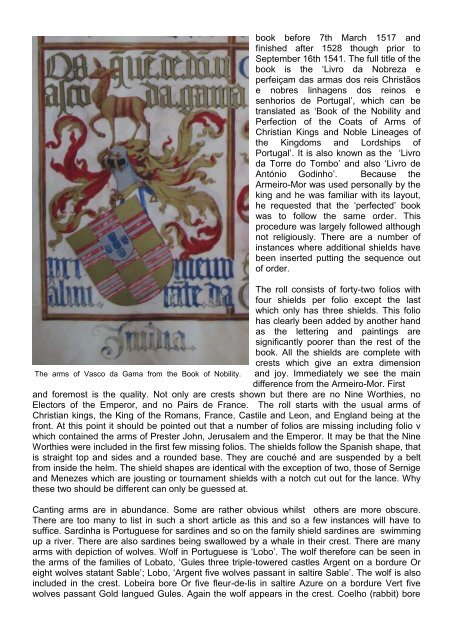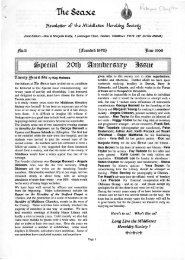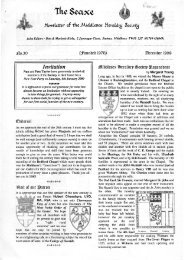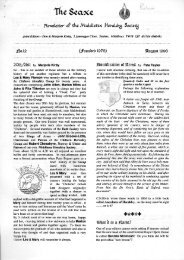No.57 - Middlesex Heraldry Society
No.57 - Middlesex Heraldry Society
No.57 - Middlesex Heraldry Society
You also want an ePaper? Increase the reach of your titles
YUMPU automatically turns print PDFs into web optimized ePapers that Google loves.
ook before 7th March 1517 and<br />
finished after 1528 though prior to<br />
September 16th 1541. The full title of the<br />
book is the „Livro da Nobreza e<br />
perfeiçam das armas dos reis Christãos<br />
e nobres linhagens dos reinos e<br />
senhorios de Portugal‟, which can be<br />
translated as „Book of the Nobility and<br />
Perfection of the Coats of Arms of<br />
Christian Kings and Noble Lineages of<br />
the Kingdoms and Lordships of<br />
Portugal‟. It is also known as the „Livro<br />
da Torre do Tombo‟ and also „Livro de<br />
António Godinho‟. Because the<br />
Armeiro-Mor was used personally by the<br />
king and he was familiar with its layout,<br />
he requested that the „perfected‟ book<br />
was to follow the same order. This<br />
procedure was largely followed although<br />
not religiously. There are a number of<br />
instances where additional shields have<br />
been inserted putting the sequence out<br />
of order.<br />
The roll consists of forty-two folios with<br />
four shields per folio except the last<br />
which only has three shields. This folio<br />
has clearly been added by another hand<br />
as the lettering and paintings are<br />
significantly poorer than the rest of the<br />
book. All the shields are complete with<br />
crests which give an extra dimension<br />
The arms of Vasco da Gama from the Book of Nobility. and joy. Immediately we see the main<br />
difference from the Armeiro-Mor. First<br />
and foremost is the quality. Not only are crests shown but there are no Nine Worthies, no<br />
Electors of the Emperor, and no Pairs de France. The roll starts with the usual arms of<br />
Christian kings, the King of the Romans, France, Castile and Leon, and England being at the<br />
front. At this point it should be pointed out that a number of folios are missing including folio v<br />
which contained the arms of Prester John, Jerusalem and the Emperor. It may be that the Nine<br />
Worthies were included in the first few missing folios. The shields follow the Spanish shape, that<br />
is straight top and sides and a rounded base. They are couché and are suspended by a belt<br />
from inside the helm. The shield shapes are identical with the exception of two, those of Sernige<br />
and Menezes which are jousting or tournament shields with a notch cut out for the lance. Why<br />
these two should be different can only be guessed at.<br />
Canting arms are in abundance. Some are rather obvious whilst others are more obscure.<br />
There are too many to list in such a short article as this and so a few instances will have to<br />
suffice. Sardinha is Portuguese for sardines and so on the family shield sardines are swimming<br />
up a river. There are also sardines being swallowed by a whale in their crest. There are many<br />
arms with depiction of wolves. Wolf in Portuguese is „Lobo‟. The wolf therefore can be seen in<br />
the arms of the families of Lobato, „Gules three triple-towered castles Argent on a bordure Or<br />
eight wolves statant Sable‟; Lobo, „Argent five wolves passant in saltire Sable‟. The wolf is also<br />
included in the crest. Lobeira bore Or five fleur-de-lis in saltire Azure on a bordure Vert five<br />
wolves passant Gold langued Gules. Again the wolf appears in the crest. Coelho (rabbit) bore














